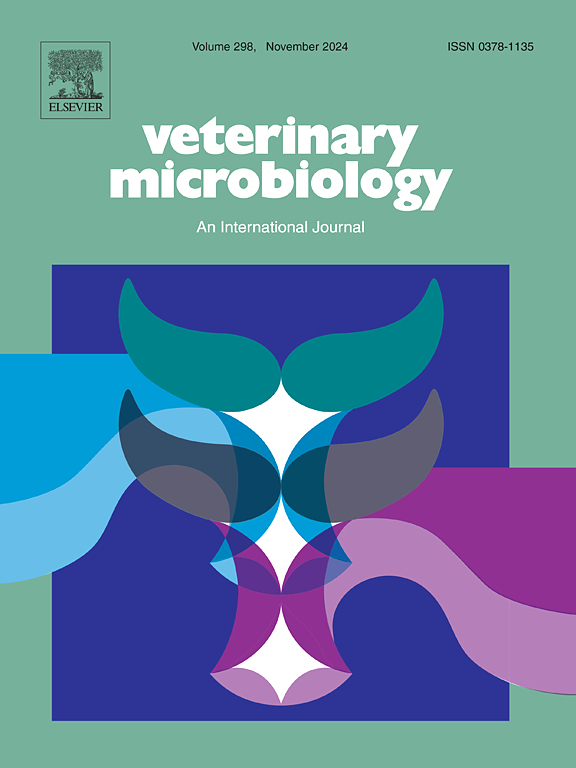Genomic surveillance of antimicrobial resistance in bovine fecal samples from Lebanon
IF 2.7
2区 农林科学
Q3 MICROBIOLOGY
引用次数: 0
Abstract
Antimicrobial resistance (AMR) threatens human and animal health worldwide, driven by the spread of extended-spectrum β-lactamase (ESBL)-producing, and carbapenem-resistant Gram-negative bacteria. In Lebanon, inadequate surveillance and antibiotic misuse worsen the issue. Animal fecal material is an important reservoir of resistance genes and mobile elements. This study aims to address AMR in bovine feces. To achieve this, bovine fecal samples were collected from 24 farms in Lebanon. Sixty-two ESBL-producing bacteria were recovered on CHROMagar ESBL and whole-genome sequencing followed by in silico typing was used to determine the resistance genes, virulence factors, and mobile genetic elements. Disk diffusion assay revealed the prevalence of multidrug-resistant (MDR) Gram-negative bacteria (33/62) with Escherichia coli being the most common (37/62). Resistance to amoxicillin, ceftriaxone, and cefotaxime was detected in all 37 E. coli isolates, with one also exhibiting resistance to colistin. β-lactam resistance was primarily associated with blaCTX-M-15 and blaTEM-1B, while colistin resistance was linked to mcr-1.1 on an IncHI2A/IncFIC multi-replicon plasmid. Plasmid typing identified 22 replicons, the most common being IncFIB and IncFII. Virulence factor analysis identified enterotoxin-encoding genes in one E. coli isolate, suggesting a potentially pathogenic strain with diarrheagenic properties among the recovered isolates. The findings of this study revealed highly resistant Gram-negative bacteria with plasmid-mediated resistance to critical antibiotics such as colistin, emphasizing the risks posed to human and livestock health. Comprehensive surveillance and responsible antibiotic use, guided by an integrated One Health approach, are essential steps to effectively tackle the interconnected challenges of AMR.
黎巴嫩牛粪便样本抗微生物药物耐药性的基因组监测
由于产生广谱β-内酰胺酶(ESBL)和耐碳青霉烯革兰氏阴性菌的传播,抗菌素耐药性(AMR)威胁着全世界人类和动物的健康。在黎巴嫩,监测不足和抗生素滥用加剧了这一问题。动物粪便是抗性基因和活动因子的重要储存库。本研究旨在解决牛粪便中的抗生素耐药性问题。为此,从黎巴嫩的24个农场收集了牛粪便样本。在CHROMagar ESBL上回收62株产ESBL细菌,采用全基因组测序和计算机分型技术确定耐药基因、毒力因子和移动遗传元件。圆盘扩散法检测结果显示革兰氏阴性多药耐药菌(33/62),其中以大肠杆菌(37/62)最为常见。在所有37株大肠杆菌中均检测到对阿莫西林、头孢曲松和头孢噻肟耐药,其中一株也对粘菌素耐药。β-内酰胺耐药主要与blaCTX-M-15和blaTEM-1B相关,而粘菌素耐药与IncHI2A/IncFIC多复制子质粒上的mcr-1.1相关。质粒分型鉴定出22个复制子,最常见的是IncFIB和IncFII。毒力因子分析在一个大肠杆菌分离株中鉴定出肠毒素编码基因,表明在回收的分离株中存在具有致泻性的潜在致病性菌株。这项研究的结果揭示了高度耐药的革兰氏阴性细菌对粘菌素等关键抗生素具有质粒介导的耐药性,强调了对人类和牲畜健康构成的风险。在“同一个健康”综合方针的指导下,全面监测和负责任地使用抗生素,是有效应对抗生素耐药性相互关联的挑战的必要步骤。
本文章由计算机程序翻译,如有差异,请以英文原文为准。
求助全文
约1分钟内获得全文
求助全文
来源期刊

Veterinary microbiology
农林科学-兽医学
CiteScore
5.90
自引率
6.10%
发文量
221
审稿时长
52 days
期刊介绍:
Veterinary Microbiology is concerned with microbial (bacterial, fungal, viral) diseases of domesticated vertebrate animals (livestock, companion animals, fur-bearing animals, game, poultry, fish) that supply food, other useful products or companionship. In addition, Microbial diseases of wild animals living in captivity, or as members of the feral fauna will also be considered if the infections are of interest because of their interrelation with humans (zoonoses) and/or domestic animals. Studies of antimicrobial resistance are also included, provided that the results represent a substantial advance in knowledge. Authors are strongly encouraged to read - prior to submission - the Editorials (''Scope or cope'' and ''Scope or cope II'') published previously in the journal. The Editors reserve the right to suggest submission to another journal for those papers which they feel would be more appropriate for consideration by that journal.
Original research papers of high quality and novelty on aspects of control, host response, molecular biology, pathogenesis, prevention, and treatment of microbial diseases of animals are published. Papers dealing primarily with immunology, epidemiology, molecular biology and antiviral or microbial agents will only be considered if they demonstrate a clear impact on a disease. Papers focusing solely on diagnostic techniques (such as another PCR protocol or ELISA) will not be published - focus should be on a microorganism and not on a particular technique. Papers only reporting microbial sequences, transcriptomics data, or proteomics data will not be considered unless the results represent a substantial advance in knowledge.
Drug trial papers will be considered if they have general application or significance. Papers on the identification of microorganisms will also be considered, but detailed taxonomic studies do not fall within the scope of the journal. Case reports will not be published, unless they have general application or contain novel aspects. Papers of geographically limited interest, which repeat what had been established elsewhere will not be considered. The readership of the journal is global.
 求助内容:
求助内容: 应助结果提醒方式:
应助结果提醒方式:


